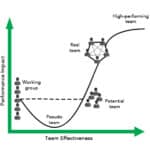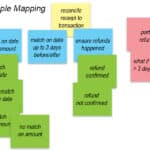In our Scrum Alone is Not Enough discussion on Portfolio Management, we talked about what it is, and how the use of a Portfolio Kanban Board can help visualize challenges that are inhibiting work, including with parallel teams. That was tricky enough, but now let’s tackle an even bigger challenge: managing work that happens before […]
Kanban Portfolio View
(Presented as Part 3 in the Scrum Alone is Not Enough series.) In the last post of this series I talked about Portfolio Management, and how it aims to ensure that a team is always working on the highest priority work, without outside pressure taking their focus away from a manageable goal. Portfolio Management has […]
Portfolio Management
(Presented as Part 2 in the Scrum Alone is Not Enough series.) As mentioned in the introduction to the Scrum Alone is Not Enough series, Scrum is simply the framework and, to work best, other tools and patterns need to be incorporated to build the most effective systems. In many organizations, we see common challenges: […]
Characteristics of Effective Scrum Teams
Grouping individuals together doesn’t make them a team. It takes more than just a label to turn a collection of people into an Effective Team. In 1993, Jon Katzenbach and Douglas Smith published, The Wisdom of Teams[1], which highlighted the difference between Working Groups and Real Teams. In this article, we summarize Katzenbach and Smith’s […]
Example Mapping: Your Secret Weapon for Effective Acceptance Criteria
Example mapping is a collaborative technique for a team to take a User Story (or PBI) and have a deeper conversation to clarify their understanding of it. The conversation generates the Acceptance Criteria. (Acceptance Criteria is the generic idea – Example Mapping is the approach I generally recommend.) We need an example. Let’s pretend that we’re building […]
Agile Tools for Job Search – An Evolving Post
In recent months I have seen hundreds of people on LinkedIn and other places, who have been laid off. I see many people encouraged by well-intentioned, helpful outplacement services to tweak their resumes to get ingested by a ranking tool. If you’re lucky this might result in an interview and in some rare cases a […]
Onboard New People Without Losing Scrum Team Magic
Agile teams have been struggling since the earliest days with how to bring new people on to a team. In one of the first Agile books, there was a story of Alistair Cockburn walking a new hire through the team’s flip charts and telling the story of their work. I haven’t seen a team use […]
Sprint Goals Provide Purpose
Go Beyond Merely Completing Work Lists with a Sprint Goal Research shows that people, whether acting individually or as a team, achieve more when working toward an objective that is specific, challenging, and concrete.[1] For that, we need clear Sprint Goals. A Sprint should be so much more than just completing a number of User […]







